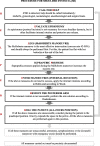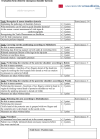Action competence in obstetric emergencies-can this be achieved via e-learning? Interprofessional blended learning module on diagnostics and emergency treatment of shoulder dystocia
- PMID: 37202818
- PMCID: PMC10193687
- DOI: 10.1186/s12909-023-04335-9
Action competence in obstetric emergencies-can this be achieved via e-learning? Interprofessional blended learning module on diagnostics and emergency treatment of shoulder dystocia
Abstract
Background: Due to the rarity of shoulder dystocia, an obstetric emergency, it is difficult even for experts to develop the appropriate routine in this emergency. Regular further training is therefore recommended for obstetricians and midwives. Evidence is lacking on the extent to which e-learning as a teaching method can be successfully used to acquire these skills and put them into practice. The purpose of this study is to demonstrate how the learning objectives for shoulder dystocia, listed in the National Competence Based Learning Objectives Catalog for Medicine (NKLM, Germany) can be successfully taught in medical studies using a blended learning concept (e-learning and practical application on a birth simulator).
Methods: After completing an e-learning course, final year medical students and midwife trainees demonstrated their action competence for shoulder dystocia procedure on a birth simulator. This transfer of the theoretical knowledge to the case study was assessed using an evaluation form oriented to the recommendations for action.
Results: One hundred sixty medical students and 14 midwifery trainees participated in the study from April to July 2019. Overall, 95.9% of the study participants met the required standards, i.e. achieved very good to adequate performance (Ø good) in simulation training.
Conclusions: E-learning with annotated high-quality learning videos is an excellent way to transfer theoretical knowledge about shoulder dystocia procedures into medical practice on a birth simulator. The learning objectives required by the NKLM for shoulder dystocia can be successfully conveyed to students via the applied blended learning concept.
Keywords: Medical studies; Obstetrics; Shoulder dystocia; e-learning.
© 2023. The Author(s).
Conflict of interest statement
The authors declare no competing interests.
Figures






Similar articles
-
The improvement and retention of skills in shoulder dystocia management with the use of high-fidelity simulation: The SAFE (SimulAtion high-FidElity) study.Women Birth. 2024 May;37(3):101590. doi: 10.1016/j.wombi.2024.02.006. Epub 2024 Feb 16. Women Birth. 2024. PMID: 38368201
-
Effect of high-fidelity shoulder dystocia simulation on emergency obstetric skills and crew resource management skills among residents.Int J Gynaecol Obstet. 2016 Dec;135(3):338-342. doi: 10.1016/j.ijgo.2016.06.023. Epub 2016 Aug 27. Int J Gynaecol Obstet. 2016. PMID: 27622684
-
Shoulder Dystocia: Quality, Safety, and Risk Management Considerations.Clin Obstet Gynecol. 2016 Dec;59(4):841-852. doi: 10.1097/GRF.0000000000000228. Clin Obstet Gynecol. 2016. PMID: 27662543 Review.
-
Video analysis of real-life shoulder dystocia to assess technical and non-technical performance.Acta Obstet Gynecol Scand. 2024 Oct;103(10):1985-1993. doi: 10.1111/aogs.14900. Epub 2024 Jun 24. Acta Obstet Gynecol Scand. 2024. PMID: 38925557 Free PMC article.
-
Simulation and Shoulder Dystocia.Clin Obstet Gynecol. 2016 Dec;59(4):853-858. doi: 10.1097/GRF.0000000000000238. Clin Obstet Gynecol. 2016. PMID: 27660929 Review.
References
-
- Pedain CHG, Julio. Fallbuch Gynäkologie und Geburtshilfe. 2. Auflage ed. Heidelberg: Thieme; 2011.
-
- Uhl B. Gynäkologie und Geburtshilfe compact. 6., vollständig überarbeitete und erweiterte Auflage ed. Heidelberg: Thieme; 2017.
-
- Jahn-Zöhrens U. Kreißsaal. 2. Auflage ed. Heidelberg: Thieme; 2018.
-
- Kainer F. Facharzt Geburtsmedizin. 2. Auflage ed. München: Urban & Fischer / Elsevier Verlag; 2011.
-
- Schneider H, Husslein P-W, Schneider K-T. Die Geburtshilfe. 5. Auflage ed. Wiesbaden: Springer Verlag; 2016.
MeSH terms
LinkOut - more resources
Full Text Sources
Miscellaneous

